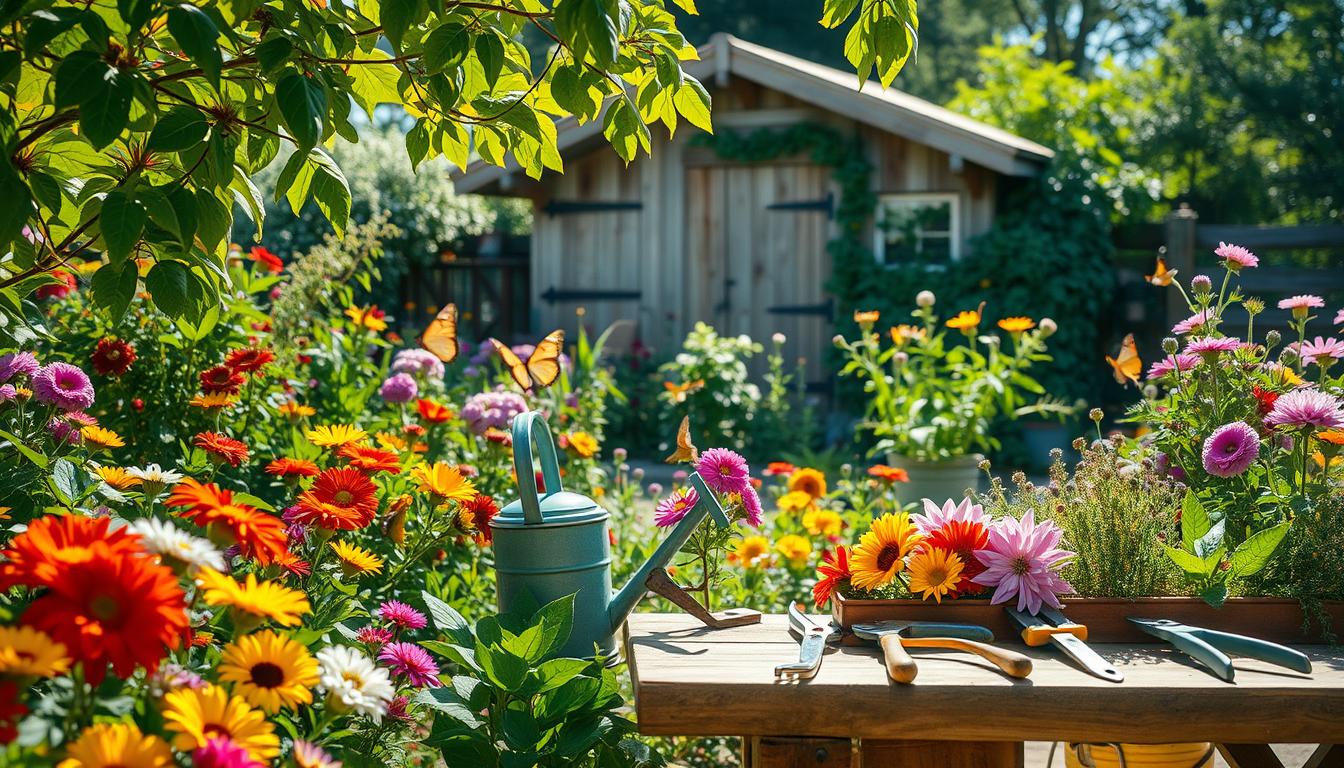When I walk into my garden on a warm summer day, I remember how vital summer garden care is. A well-kept garden is not just pretty. It’s also a peaceful escape from our busy lives.
Keeping my garden healthy means giving my plants the right water, nutrients, and care. By following the best practices, I can make my garden stunning and healthy. This article will share my knowledge on how to keep your garden looking great.
I’ll cover everything from watering to pest control. This guide is for both experienced gardeners and beginners. It will help you keep your yard beautiful with simple, effective methods.
Understanding the Basics of Summer Garden Care
When I enter my garden in summer, I remember the need for seasonal care. The heat and dryness can harm my plants. It’s key to give them the right care to help them grow.
Summer garden care is about finding the right balance. This includes watering, fertilizing, and pruning. These steps help keep my garden healthy and full of life.
To start, I focus on essential tasks for my summer garden. These are pruning, fertilizing, and watering. By doing these, my garden can handle the summer’s heat and dryness.
The Importance of Seasonal Maintenance
Seasonal maintenance is crucial for a healthy garden, especially in summer. My garden needs extra care to stay vibrant. I regularly check my plants for stress or disease signs.
Key Tasks for My Summer Garden
Some important tasks for my summer garden are:
- Pruning: to promote growth and prevent overgrowth
- Fertilizing: to provide essential nutrients for healthy plant development
- Watering: to keep my plants hydrated and thriving
By following these tips and staying on top of maintenance, I can enjoy a beautiful garden all summer. 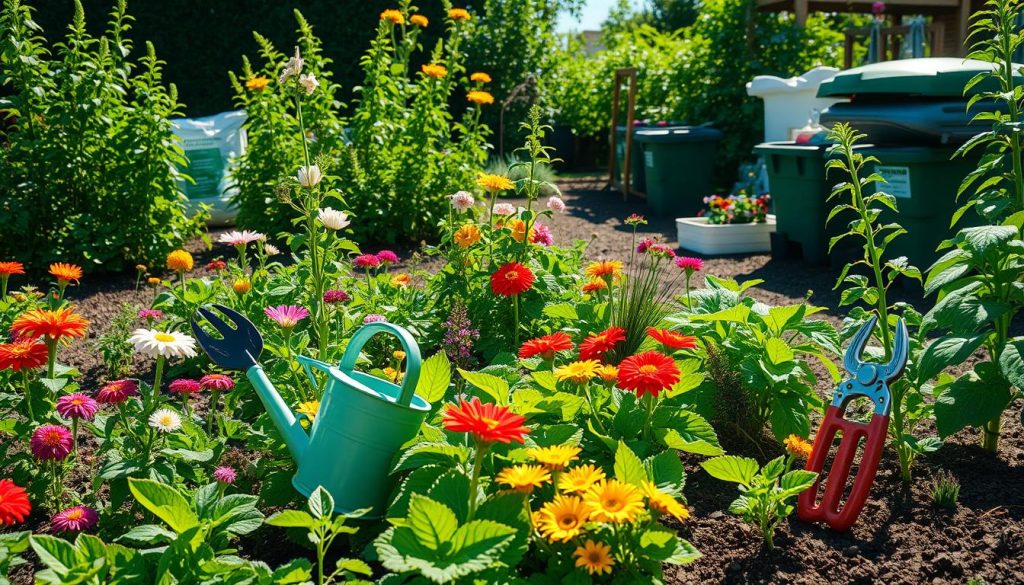
Watering Strategies for a Thriving Garden
To keep my garden healthy, I need the right tools and a good watering plan. A checklist helps me remember to water my plants. The type of plants and the climate I live in affect how often I water.
Using the right tools, like a watering can or a hose, makes watering easier. A checklist also helps me know which plants need more water and which can do with less. This way, I avoid harming my plants with too much or too little water.
How Often Should I Water?
How often to water depends on the plants, soil, and climate. I water when the top inch of soil feels dry. This helps prevent root rot and other issues. I also check the weather forecast to adjust my watering schedule.
Best Times to Water in Summer
Watering at the right time helps prevent water loss and disease. I water in the early morning or evening. This way, my plants get the water they need without losing it to evaporation. With the right tools and a good watering plan, my garden stays healthy all summer.
Here’s a simple checklist to help me stay on track:
- Water plants in the early morning or evening
- Check soil moisture before watering
- Use the right tools, such as a watering can or hose with a spray nozzle
- Adjust watering schedule based on weather forecast
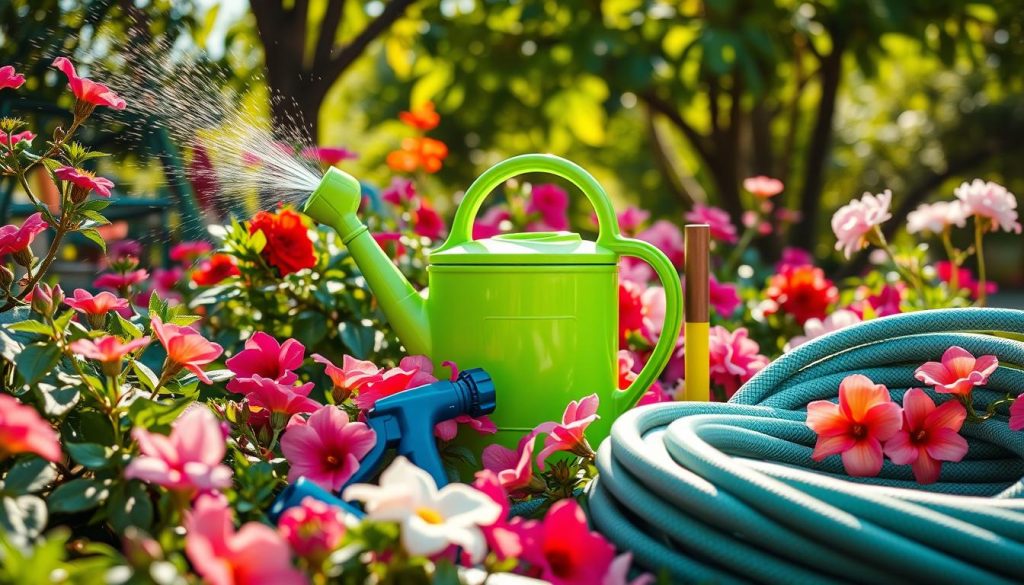
Fertilizing My Plants for Optimal Growth
As I care for my summer garden, I’ve learned how vital fertilizing is. There are many choices, from professional help to DIY methods. It’s key to pick the right one for my plants’ needs.
I have two main choices: getting help from pros or doing it myself. Professionals offer custom advice, while DIY lets me control my garden’s diet. No matter what, following the instructions is crucial to avoid harming my plants.
Choosing the Right Fertilizer
To make a good choice, I must think about what my plants need. There are many organic and inorganic fertilizers, each with its own benefits and downsides. Picking the right one ensures my plants get the nutrients they need to grow well.
Application Techniques that Work
After picking the right fertilizer, applying it correctly is key. I must follow the recommended amounts and timing to avoid harming my plants. Techniques like soil testing help me adjust my fertilizing plan. This way, I can give my plants the best chance to grow and thrive.
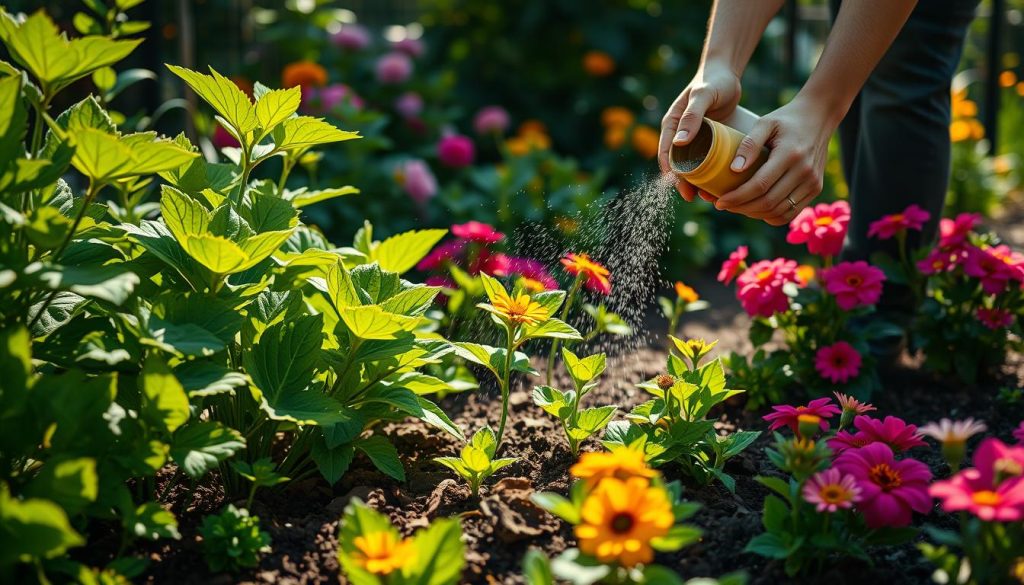
By carefully choosing how to fertilize my plants, I can make my summer garden flourish. Whether I use professional help or DIY, the goal is to give my plants the nutrients they need to grow strong and healthy.
| Fertilizer Type | Benefits | Drawbacks |
|---|---|---|
| Organic Fertilizer | Environmentally friendly, promotes soil health | May be more expensive, slower release of nutrients |
| Inorganic Fertilizer | Quick release of nutrients, often less expensive | May harm soil health, contribute to environmental pollution |
Dealing with Weeds Effectively
Weeds can be a big problem in my summer garden. They compete with my plants for water and nutrients. To solve this, I first identify common summer weeds. This is key for my plants to get the care they need.
Understanding the weeds in my garden is crucial. I’ve learned about crabgrass, dandelions, and clover. After identifying them, I use methods like hand-pulling, mulching, or herbicides. I choose the best method for my garden and plants.
Methods for Weed Control
- Hand-pulling: This method is effective for small areas of weeds and can be done regularly to prevent weed growth.
- Mulching: Applying a layer of mulch can help suppress weed growth by blocking light and preventing seed germination.
- Herbicides: Chemical herbicides can be used to control weeds, but it’s essential to choose the right type and follow the instructions carefully to avoid harming my plants.
By using these methods, my garden stays healthy and thriving. Regular care, including weed control, is key. 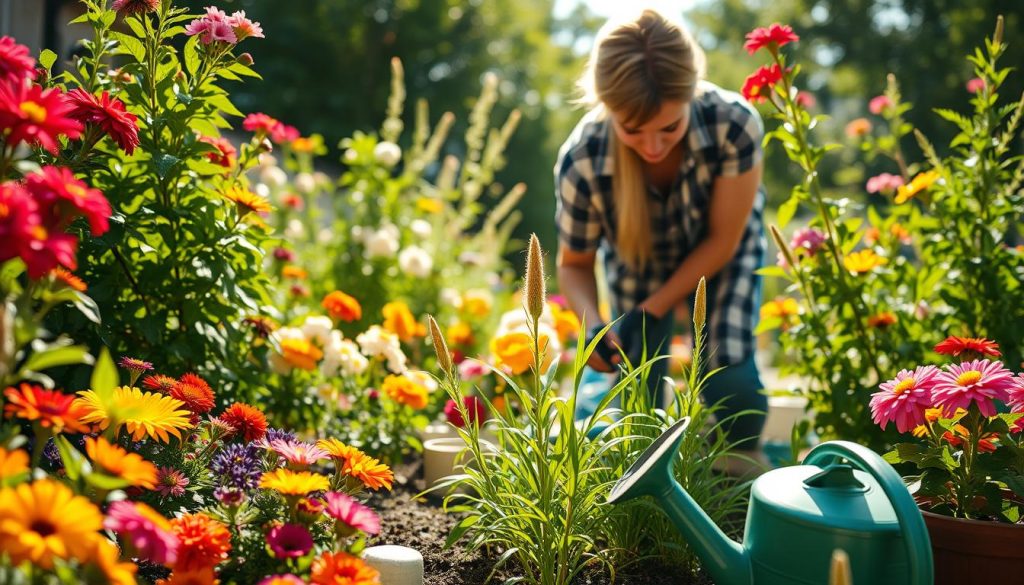
Preventing Future Weed Growth
To stop weeds from coming back, I keep my garden healthy. I water, fertilize, and prune regularly. This makes my plants strong and less likely to have weeds.
Pruning Techniques for Healthier Plants
As I care for my summer garden, I’ve learned pruning is key. It promotes growth, encourages fruiting, and removes bad branches. To prune well, it’s important to know the best practices for each plant.
Timing is crucial when pruning. I prune in the early morning or evening to avoid stressing my plants. Using the right tools, like pruning shears or loppers, is also important. It helps make clean cuts and prevents disease spread.
Essential Pruning Tools
- Pruning shears for cutting stems and branches
- Loppers for thicker branches and stems
- Pruning saw for cutting larger branches
By following these tips, my plants grow stronger and healthier. Pruning is an art that needs patience and attention to detail. With the right techniques and tools, my garden will flourish, and I’ll enjoy a great harvest.
Pest Management in My Summer Garden
To keep my summer garden healthy, I must manage pests well. I recognize common pests and use the right tools to fight them. A magnifying glass and a pest guide are key for spotting pests. A checklist helps me stay organized and remember to check my plants often.
I’ve seen aphids, whiteflies, and spider mites in my garden. To fight these, I mix organic pest control with beneficial insects. For aphids, I use neem oil or insecticidal soap. Ladybugs or lacewings help with whiteflies and spider mites.
Recognizing Common Pests
- Aphids: small, soft-bodied insects that feed on plant sap
- Whiteflies: tiny, winged insects that feed on plant sap and can transmit diseases
- Spider mites: tiny, spider-like insects that feed on plant sap and can cause yellowing or bronzing of leaves
Safe Solutions to Combat Infestations
Along with organic methods and beneficial insects, I use physical barriers and traps. Fine-mesh screens keep whiteflies and aphids away. Sticky traps capture spider mites and other pests. This mix keeps my garden pest-free and healthy.
Keeping My Garden Hydrated
To keep my garden hydrated, especially in the hot summer, I use mulch. It helps keep the soil moist by reducing evaporation. This ensures my plants get enough water to grow well. I also think about getting irrigation systems for bigger gardens or areas with little rain.
Professional services can design and install irrigation systems for my garden. Important things to consider include:
- Soil type and its water-holding capacity
- Climate and rainfall patterns in my area
- Types of plants and their water requirements
Using DIY techniques like mulching and professional services for irrigation systems helps. This way, my garden stays hydrated and healthy all summer.
| Method | Benefits | Considerations |
|---|---|---|
| Mulching | Moisture retention, weed suppression | Cost, maintenance requirements |
| Irrigation systems | Efficient water use, convenience | Initial investment, potential for overwatering |
By looking at the pros and cons of each method, I can choose the best way to keep my garden hydrated and healthy.
Harvesting Time: When to Gather Produce
Walking through my summer garden fills me with excitement. It’s time to pick the fruits of my hard work. Harvesting is key to summer garden care. Knowing when to pick my produce is crucial for the best taste and texture.
There are clear signs that tell me when to harvest. Color, texture, and size changes are key indicators. For instance, a ripe tomato turns from green to red. A cucumber is dark green and firm. Following the best garden care tips helps me get a great harvest.
Signs My Fruits and Vegetables are Ready
- Changes in color: Fruits and vegetables will often change color as they ripen.
- Texture: A ripe fruit or vegetable will be slightly soft to the touch, but still firm enough to hold its shape.
- Size: Most fruits and vegetables will be fully grown and ready to harvest when they reach their full size.
Best Practices for Harvesting
To get the best results, I follow some simple steps. I use sharp tools and handle the produce carefully to avoid damage. I also harvest in the early morning or evening to avoid heat stress. By doing this, I ensure a successful and rewarding harvest.
Preparing for the Next Season
As summer ends, it’s time to plan for the next season. This means getting ready for the changes that come with it.
Fall planning starts now. It’s important to prepare your garden for the weather changes. Think about the plants you have and what they need.
Fall Planning Starts Now
Start planning for fall to make the transition smooth. Clean up debris, add organic matter to the soil, and plan your next garden. These steps will help your garden thrive in the next season.
How to Transition After Summer Ends
As the weather cools and days get shorter, your garden needs a new approach. Learn how to care for your garden in the fall. Adjust watering, choose plants that do well in the fall, and protect your garden from harsh weather. With some preparation, your garden will stay healthy and vibrant.

